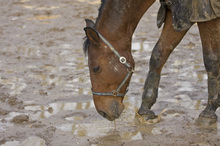Drought stricken areas such as California and Texas have been hoping for rain for at least the past four years. Now heavy rains and some flooding are bringing much needed moisture to the states, but, in spite of the relief that rain brings to drought-stricken areas, the extra moisture can create health problems for horses because of the increased insect population and prolonged exposure to wet, muddy areas.

Standing water and mud - A threat to horse hoof health
In spite of the relief that rain brings to drought-stricken areas such as California and Texas, the extra moisture can create health problems for horses because of the increased insect population and prolonged exposure to wet, muddy areas.
With the extra moisture, horse owners need to be on the lookout for health problems in their horses including more insect-borne diseases, skin and hoof problems.
Biting insect populations increase significantly following excessive rainfall and thrive in flooded and previously flooded areas. Mosquitoes and biting flies spread a number of viral diseases, such as Eastern Equine Encephalitis (EEE), Western Equine Encephalitis (WEE) and West Nile virus (WNV).
The natural disease cycle is a bird/mosquito transmission cycle. When the virus becomes more prevalent in nature, it may âspill overâ into horses, other animals and humans.
The prolonged wet weather also increases the risk of skin and feet infections in horses. âAn animal living on wet ground with no shelter from the rain, or standing in water, can potentially develop hoof abscesses, various dermatologic conditions and a host of other diseases,â said Terry Hensley, MS, DVM.
Incidents of rain rot, rain scald, scratches, mud fever, a common bacterial dermatitis caused by Dermatophilis congolensis increase during wet weather. The most important factors in the initiation of dermatophilosis are skin damage and moisture. The exudative, crusted lesions are found over the rump and topline, face and neck and pasterns, coronets and heels in horses.
Wet, poorly drained pastures and paddocks are commonly associated with the distal limb dermatitis. A definitive diagnosis is based on cytology, skin biopsy and culture.
In addition, wet muddy conditions can predispose horses to foot infections. Horses who are in wet, muddy pastures/paddocks are at increased risk of developing hoof abscesses. The horse will present with lameness and should be examined by a veterinarian to determine the extent of the infection and foot structures involved.
